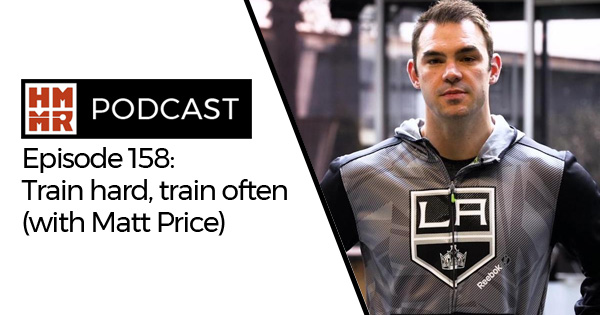Regardless of the unique demands of the sport or league, high performance coaches across the NBA, Premier League, MLB, NHL, and beyond all face a common challenge: the prolonged grind of the regular season threatens to sap the strength and speed gains they worked to achieve in the pre-season. Matt Price, head strength and conditioning coach of the LA Kings, recently joined Martin Bingisser and Nick Garcia on the HMMR Media Podcast to discuss the new methods and technologies he applies for maintaining strength and robustness in-season with his ice hockey players.
“Traditionally, weight lifting or strength work was done post-game,” Price told Bingisser and Garcia during the course of their in-depth discussion. “And so, in the NHL they play 82 games over about 160-170 days, so you’re playing every-other day on average. The thought process is that you are going to load the athletes and strength train them after a game so that they had the maximum time to recover from that workout so they weren’t sore and tired before they played again. For a long time, that’s how a lot of people in the league did it.”
Following the peaks of adrenaline, stress, and exertion in a hockey game, however, Price found his athletes weren’t in an ideal psychological or physiological state to positively adapt to a training stimulus. Incorporating concepts of microdosing from Derek Hansen as well as the tenets of Tim Gabbett’s Acute:Chronic Workload Ratio, two years ago Price instead began to apply chronic bouts of very low volume/high intensity work during his in-season training sessions.
[av_button_big label=’More ice hockey:’ description_pos=’below’ link=’manually,https://1080motion.com/hockey-summit-1080-sprint/’ link_target=” icon_select=’no’ icon=’ue800′ font=’entypo-fontello’ custom_font=’#ffffff’ color=’theme-color’ custom_bg=’#444444′ color_hover=’theme-color-subtle’ custom_bg_hover=’#444444′ av_uid=’av-1646qal’]
Fusing training and testing with the 1080 Sprint at The Hockey Summit
[/av_button_big]
“Microdosing was a way for me to apply a small stimulus to the athlete across virtually any day of the week we wanted,” Price explains in the podcast. “And we were finding that we were getting a much better strength maintenance—or in some cases improved strength qualities—during the competitive season. We did that through the use of some advanced equipment. We were very fortunate to work with the 1080 Quantum Syncro machine, so we are using very dynamic isokinetic loading now, which is an unbelievable stimulus for our athletes in a concentric-only action.”
Efficiency is the key, as Price is able to keep his in-season strength workouts as short as 10 minutes, focusing on two or three primary lifts. These are programmed to effectively balance tissue-based adaptations and neuromuscular drive, all while achieving crucial athlete buy-in.
“Where the 1080 equipment has become really valuable, there’s this comfort level with it. They feel safe. There’s no eccentric load on the machine, it’s not real ‘weight.’ So they’re putting out values that are equivalent to 400 pounds of peak force on a single leg, where obviously I would get nowhere near that with real weight.
[av_button_big label=’Next post:’ description_pos=’below’ link=’manually,https://1080motion.com/1080-sprint-post-activation-potentiation-university-guelph/’ link_target=” icon_select=’no’ icon=’ue800′ font=’entypo-fontello’ custom_font=’#ffffff’ color=’theme-color’ custom_bg=’#444444′ color_hover=’theme-color-subtle’ custom_bg_hover=’#444444′ av_uid=’av-rdai65′]
1080 Sprint: After-hours work outshines ‘negative results’ at University of Guelph
[/av_button_big]
“It’s been very enlightening, it’s been paradigm-shifting, and I feel strongly I can quantify the impact it’s had on our athletes.”






























































